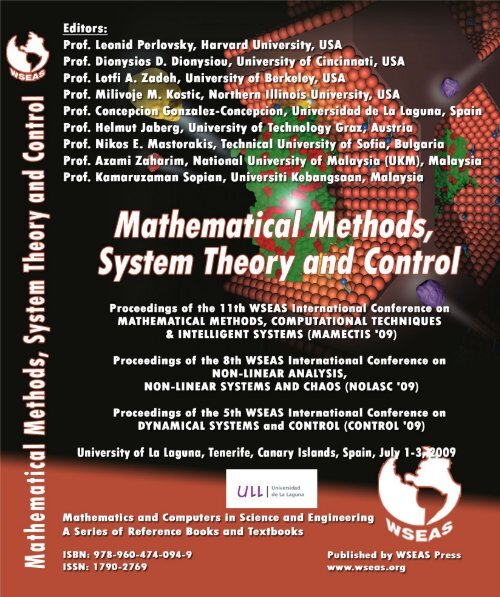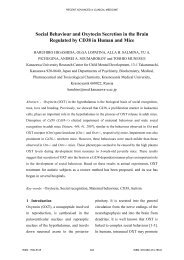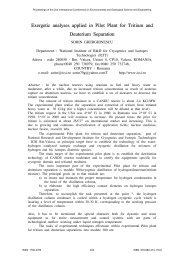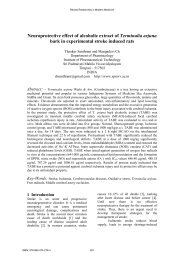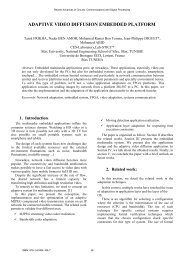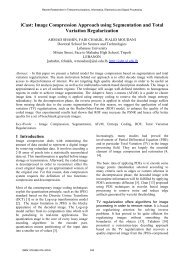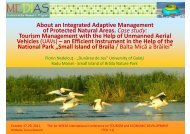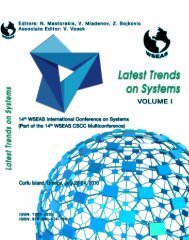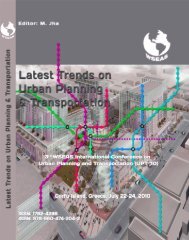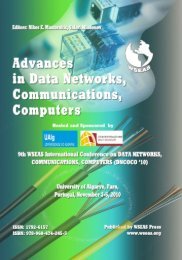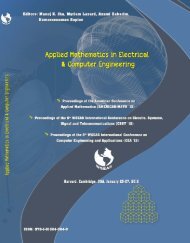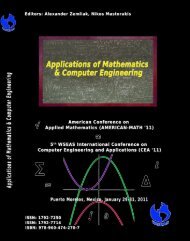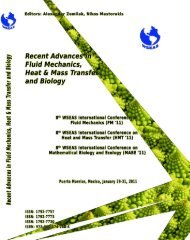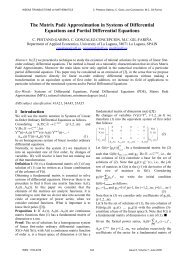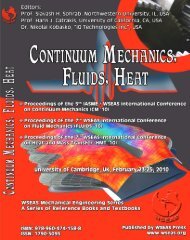Mathematical Methods, System Theory and Control ... - Wseas.us
Mathematical Methods, System Theory and Control ... - Wseas.us
Mathematical Methods, System Theory and Control ... - Wseas.us
Create successful ePaper yourself
Turn your PDF publications into a flip-book with our unique Google optimized e-Paper software.
<strong>Mathematical</strong> <strong>Methods</strong>, <strong>System</strong> <strong>Theory</strong><br />
<strong>and</strong> <strong>Control</strong><br />
Proceedings of the 11th WSEAS International Conference on<br />
MATHEMATICAL METHODS, COMPUTATIONAL<br />
TECHNIQUES AND INTELLIGENT SYSTEMS (MAMECTIS '09)<br />
Proceedings of the 8th WSEAS International Conference on NON-<br />
LINEAR ANALYSIS, NON-LINEAR SYSTEMS AND CHAOS<br />
(NOLASC '09)<br />
Proceedings of the 5th WSEAS International Conference on<br />
DYNAMICAL SYSTEMS <strong>and</strong> CONTROL (CONTROL '09)<br />
University of La Laguna, Tenerife, Canary Isl<strong>and</strong>s<br />
Spain, July 1-3, 2009<br />
Mathematics <strong>and</strong> Computers in Science <strong>and</strong> Engineering<br />
A Series of Reference Books <strong>and</strong> Textbooks<br />
Published by WSEAS Press ISSN: 1790-2769<br />
www.wseas.org<br />
ISBN: 978-960-474-094-9
<strong>Mathematical</strong> <strong>Methods</strong>, <strong>System</strong> <strong>Theory</strong><br />
<strong>and</strong> <strong>Control</strong><br />
Proceedings of the 11th WSEAS International Conference on<br />
MATHEMATICAL METHODS, COMPUTATIONAL<br />
TECHNIQUES AND INTELLIGENT SYSTEMS (MAMECTIS '09)<br />
Proceedings of the 8th WSEAS International Conference on NON-<br />
LINEAR ANALYSIS, NON-LINEAR SYSTEMS AND CHAOS<br />
(NOLASC '09)<br />
Proceedings of the 5th WSEAS International Conference on<br />
DYNAMICAL SYSTEMS <strong>and</strong> CONTROL (CONTROL '09)<br />
University of La Laguna, Tenerife, Canary Isl<strong>and</strong>s<br />
Spain, July 1-3, 2009<br />
Mathematics <strong>and</strong> Computers in Science <strong>and</strong> Engineering<br />
A Series of Reference Books <strong>and</strong> Textbooks<br />
Published by WSEAS Press<br />
www.wseas.org<br />
Copyright © 2009, by WSEAS Press<br />
All the copyright of the present book belongs to the World Scientific <strong>and</strong> Engineering Academy <strong>and</strong><br />
Society Press. All rights reserved. No part of this publication may be reproduced, stored in a retrieval<br />
system, or transmitted in any form or by any means, electronic, mechanical, photocopying, recording, or<br />
otherwise, without the prior written permission of the Editor of World Scientific <strong>and</strong> Engineering Academy<br />
<strong>and</strong> Society Press.<br />
All papers of the present volume were peer reviewed by two independent reviewers. Acceptance was<br />
granted when both reviewers' recommendations were positive.<br />
See also: http://www.worldses.org/review/index.html<br />
ISSN: 1790-2769<br />
ISBN: 978-960-474-094-9<br />
World Scientific <strong>and</strong> Engineering Academy <strong>and</strong> Society
<strong>Mathematical</strong> <strong>Methods</strong>, <strong>System</strong> <strong>Theory</strong><br />
<strong>and</strong> <strong>Control</strong><br />
Proceedings of the 11th WSEAS International Conference on<br />
MATHEMATICAL METHODS, COMPUTATIONAL<br />
TECHNIQUES AND INTELLIGENT SYSTEMS (MAMECTIS '09)<br />
Proceedings of the 8th WSEAS International Conference on NON-<br />
LINEAR ANALYSIS, NON-LINEAR SYSTEMS AND CHAOS<br />
(NOLASC '09)<br />
Proceedings of the 5th WSEAS International Conference on<br />
DYNAMICAL SYSTEMS <strong>and</strong> CONTROL (CONTROL '09)<br />
University of La Laguna, Tenerife, Canary Isl<strong>and</strong>s<br />
Spain, July 1-3, 2009
Editors:<br />
Prof. Leonid Perlovsky, Harvard University, USA<br />
Prof. Dionysios D. Dionysiou, University of Cincinnati, USA<br />
Prof. Lotfi A. Zadeh, University of Berkeley, USA<br />
Prof. Milivoje M. Kostic, Northern Illinois University, USA<br />
Prof. Concepcion Gonzalez-Concepcion, Universidad de La Laguna, Spain<br />
Prof. Helmut Jaberg, University of Technology Graz, A<strong>us</strong>tria<br />
Prof. Nikos E. Mastorakis, Technical University of Sofia, Bulgaria<br />
Prof. Azami Zaharim, National University of Malaysia (UKM), Malaysia<br />
Prof. Kamaruzaman Sopian, Universiti Kebangsaan, Malaysia<br />
International Program Committee Members:<br />
D. Perkins (USA)<br />
Kent Davey (USA)<br />
David L<strong>and</strong>grebe (USA)<br />
Miguel A. Mariro (USA)<br />
C. Helmis (Greece)<br />
A. Stamou (Greece)<br />
F. Rigas (Greece)<br />
Leon Trilling (USA)<br />
D. L. R<strong>us</strong>sell (USA)<br />
Steven H. Collicott (USA)<br />
Marco Ceccarelli (Italy)<br />
John W. Lund (USA)<br />
Hamido Fujita (JAPAN)<br />
N. Afgan (Portugal)<br />
F. Akgun (Turkey)<br />
Omar Badran (Jordan)<br />
Y. Baudoin (Belgium)<br />
A. Bitoleanu (Romania)<br />
L. Boch-Andersen (Belgium)<br />
P. Casero (Spain)<br />
E. Frey (Germany)<br />
M. Heiermann (Germany)<br />
A. E. Holdo (UK)<br />
D. De Keukeleere (Belgium)<br />
M. Versan Kok (Turkey)<br />
G. Kolb (Denmark)<br />
A. Kurbatskiy (R<strong>us</strong>sia)<br />
S. Linderoth (Denmark)<br />
P. Lunghi (Italy)<br />
C. Machens (Germany)<br />
A. Midilli (Canada)<br />
J. Van Mierlo (Belgium)<br />
S. Ozdogan (Turkey)<br />
M. Reijalt (Italy)<br />
J. Rogut (Pol<strong>and</strong>)<br />
I. V. Singh (India)<br />
E. Smole (A<strong>us</strong>tria)<br />
R. Tamme (Germany)<br />
M. Teixeira (Portugal)<br />
R. Vigotti (Italy)<br />
G. Wolf (Germany)<br />
G. Wisniewski (Pol<strong>and</strong>)<br />
A. Van Zyl (Belgium)<br />
Z. A. Vale (Portugal)<br />
A. F. Zobaa (Egypt)<br />
T. Panagopoulos (Portugal)<br />
Eleni Stamatiou (Greece)<br />
Alice Hatzopoulou (Greece)<br />
J.Georgi (Greece)
Preface<br />
This year the 11th WSEAS International Conference on MATHEMATICAL METHODS,<br />
COMPUTATIONAL TECHNIQUES AND INTELLIGENT SYSTEMS (MAMECTIS '09), the<br />
8th WSEAS International Conference on NON-LINEAR ANALYSIS, NON-LINEAR<br />
SYSTEMS AND CHAOS (NOLASC '09) <strong>and</strong> the 5th WSEAS International Conference on<br />
DYNAMICAL SYSTEMS <strong>and</strong> CONTROL (CONTROL '09) were held in the University of La<br />
Laguna, Tenerife, Canary Isl<strong>and</strong>s, Spain. The Conferences remain faithful to their original idea<br />
of providing a platform to disc<strong>us</strong>s finite differences, finite volumes, fem, bem, variational<br />
calcul<strong>us</strong>, stochastic systems, non-linear systems in science, chaos <strong>and</strong> chaotic behaviour,<br />
dynamical systems, differential equations, bifurcations, stability of matter, schroedinger<br />
operators, stability, observability, controlability, factorizability, reachability, linear control, nonlinear<br />
control etc. with participants from all over the world, both from academia <strong>and</strong> from<br />
ind<strong>us</strong>try.<br />
Its success is reflected in the papers received, with participants coming from several countries,<br />
allowing a real multinational multicultural exchange of experiences <strong>and</strong> ideas.<br />
The accepted papers of this conference are published in this Book that will be indexed by ISI.<br />
Please, check it: www.worldses.org/indexes as well as in the CD-ROM Proceedings. They will<br />
be also available in the E-Library of the WSEAS. The best papers will be also promoted in many<br />
Journals for further evaluation.<br />
A Conference such as this can only succeed as a team effort, so the Editors want to thank the<br />
International Scientific Committee <strong>and</strong> the Reviewers for their excellent work in reviewing the<br />
papers as well as their invaluable input <strong>and</strong> advice.<br />
The Editors
Table of Contents<br />
Plenary Lecture 1: <strong>System</strong> Biometric: A Door to the Security 13<br />
Carlos Manuel Travieso Gonzalez<br />
Plenary Lecture 2: An Exponential-Fitting Method for the Quantum Corrected Equations 14<br />
Ren-Chuen Chen<br />
Plenary Lecture 3: Internet <strong>and</strong> Network-based Healthcare: Performance Analysis <strong>and</strong><br />
Improvements<br />
Seyed A. Shahrestani<br />
Plenary Lecture 4: Biomimetic Modeling – A New Engineering Challenge in Nanostructured<br />
Material Fabrication<br />
Mihaela Banu<br />
Plenary Lecture 5: Recent Developments in the Von Mises Transformation <strong>and</strong> its Applications<br />
in the Computational Sciences<br />
M. H. Hamdan<br />
Plenary Lecture 6: Video Enhancement Techniques Over Mobile Ad-Hoc Wireless Networks 18<br />
Tarek Saadawi<br />
Plenary Lecture 7: A New Research Direction of Chaos <strong>Control</strong>: Multi-Objective <strong>Control</strong> <strong>and</strong> its<br />
Application<br />
Jin-Qing Fang<br />
Plenary Lecture 8: Non-linear Analysis of the Automotive S<strong>us</strong>pensions with neo-Hookean<br />
Elements<br />
Nicolae-Doru Stanescu<br />
Plenary Lecture 9: Machining Process <strong>and</strong> <strong>System</strong> Stability – A Chaotic Approach 21<br />
Gabriel Frum<strong>us</strong>anu<br />
Plenary Lecture 10: Detection of Level Change (LC) Outlier in Garch(1,1) Processes 22<br />
Azami Zaharim<br />
Plenary Lecture 11: A Topological Approach of the Geometry Modeling <strong>and</strong> <strong>Control</strong> in<br />
Manufacturing<br />
Virgil Teodor<br />
Section 1: Proceedings of the 5th WSEAS International Conference on DYNAMICAL SYSTEMS<br />
<strong>and</strong> CONTROL (CONTROL '09)<br />
Stress Analysis of a High Fill-Factor Micromachined Bolometer for Thermal Imaging<br />
Applications<br />
M. Safy, A. Hafz Zaky, H. Abdalla, Y. Elshaer<br />
An Enhanced Situational Awareness of a Mission for an Autonomo<strong>us</strong> Underwater Vehicle by<br />
Multirate <strong>Control</strong><br />
Igor Astrov, Andr<strong>us</strong> Pedai<br />
Adaptive <strong>Control</strong> of 2-Link Pay-Loaded Manipulator 40<br />
Hamid keivani, Aliakbar Mohammadi, Hamid Reza Nasrfard Jahromi<br />
ISSN: 1790-2769 7 ISBN: 978-960-474-094-9<br />
15<br />
16<br />
17<br />
19<br />
20<br />
23<br />
25<br />
27<br />
33
PI Tuning for Disturbance Attenuation <strong>Control</strong> Applied to a Wastewater Treatment Plant 47<br />
R. Vilanova, R. Moreno, O. Arrieta, J. Lafuente, Victor Alfaro<br />
Dynamic Properties of a Radiometric Monitoring <strong>System</strong> 53<br />
Stanislaw Cierpisz<br />
Optimal <strong>Control</strong> for the Jibissa Absorption Plant 57<br />
Cristian Patrascioiu, Issa Rabahi, Daniel Mihaescu<br />
<strong>Control</strong> Valves - Modeling <strong>and</strong> Simulation 63<br />
Cristian Patrascioiu, Casen Panaitescu, Nicolae Paraschiv<br />
A Processing Algorithm for a Production Predictable <strong>System</strong> 69<br />
Vasile Mazilescu<br />
Topological Modelling of the Part Geometry in Manufacturing 75<br />
Alex<strong>and</strong>ru Epureanu, Virgil Teodor, Nicolae Oancea<br />
The Gear Hub Profiling for Machining Surfaces with Discreetly Expressed Surfaces 81<br />
Nicolae Oancea, Virgil Teodor, Ionut Popa, Gabriel Dura<br />
Dynamic Modeling <strong>and</strong> Stabilization of Wheeled Mobile Robot 87<br />
Alex<strong>and</strong>ru Bara, S<strong>and</strong>a Dale<br />
Online High Resolution Machining Process Optimal <strong>Control</strong> 93<br />
Florin Bogdan Marin, Vasile Marinescu, Mihaela Banu, Alex<strong>and</strong>ru Epureanu, Ionut Constantin<br />
Online Machining Errors Compensation 97<br />
Ionut Constantin, Alex<strong>and</strong>ru Epureanu, Vasile Marinescu, Mihaela Banu, Florin Bogdan Marin<br />
Increasing of the Stern Tube B<strong>us</strong>hes Precision by On-Line Adaptive <strong>Control</strong> of the Cutting<br />
Process<br />
Lucian Vasiliu, Alex<strong>and</strong>ru Epureanu, Gabriel Frum<strong>us</strong>anu, Vasile Marinescu<br />
Laboratory <strong>System</strong> for Designing <strong>and</strong> Testing <strong>Control</strong> Algorithms for Small UAV Objects 107<br />
Nawrat Aleks<strong>and</strong>er, Daniec Krzysztof, Koteras Roman, Kozak Kamil<br />
ICT Healthcare: Overcoming Complex Barriers for Successful Deployment 112<br />
Seyed A. Shahrestani<br />
<strong>Control</strong>ler Design <strong>us</strong>ing Bifurcation Map for Aircraft Spin Recovery 118<br />
D. M. K. K. Venkateswara Rao, Anshu Narang, N<strong>and</strong>an Kumar Sinha<br />
Section 2: Proceedings of the 11th WSEAS International Conference on MATHEMATICAL<br />
METHODS, COMPUTATIONAL TECHNIQUES AND INTELLIGENT SYSTEMS<br />
(MAMECTIS '09)<br />
Classification in Complex <strong>System</strong>s through Negative Recognition 127<br />
Seyed A. Shahrestani<br />
Complex <strong>System</strong> Diagnosis through Adaptive Recognition 133<br />
Seyed A. Shahrestani<br />
ISSN: 1790-2769 8 ISBN: 978-960-474-094-9<br />
102<br />
125
S-transform Based Support Vector Regression for Detection of Incipient Faults <strong>and</strong> Voltage<br />
Disturbances in Power Distribution Networks<br />
Mohamed Fuad Faisal, Azah Mohamed, Aini H<strong>us</strong>sain<br />
An Exponential-Fitting Method for the Quantum Corrected Equations 146<br />
Ren-Chuen Chen<br />
Computation in Projective Space 152<br />
Vaclav Skala<br />
Geometric Data Structures Approximations for Network Optimisation Problems 158<br />
Milos Seda, Tomas Brezina<br />
About the <strong>us</strong>e of Compact Schemes Approach for the Modelling of Fuel Pulverization<br />
Phenomenon<br />
V. Niola, C. Mongiello, A. Di Nardo<br />
The Conceptual Design of Very Light Jet 169<br />
Prasetyo Edi, Khairi Y<strong>us</strong>uf, Amir Radzi Abdul Ghani<br />
Dynamic Loading of Concentric Circular Tubes 174<br />
Lion Kok Hao, Amir Radzi Abdul Ghani, Prasetyo Edi, Khairi Y<strong>us</strong>uf<br />
Recent Developments in the von Mises Transformation <strong>and</strong> its Applications in the Computational<br />
Sciences<br />
M. H. Hamdan<br />
On the Micropolar Fluid Flow through Poro<strong>us</strong> Media 190<br />
M. T. Kamel, D. Roach, M. H. Hamdan<br />
A Permeability Function for Brinkman's Equation 198<br />
M. H. Hamdan, M. T. Kamel, H. I. Siyyam<br />
Poiseuelle Flow through a Channel Bounded by Poro<strong>us</strong> Layers 206<br />
H. I. Siyyam, M. H. Hamdan<br />
Implementation of a Fast Frequency Hopping Spread Spectrum modulator with <strong>System</strong><br />
Generator on a FPGA<br />
Santiago T. Perez, Jes<strong>us</strong> B. Alonso, Carlos M. Travieso, Miguel A. Ferrer, Jose F. Cruz<br />
Aerodynamic Profile Parameterization <strong>and</strong> Optimization 218<br />
Valeriu Vilag, Jeni Popescu, Romul<strong>us</strong> Petcu, Valentin Silivestru<br />
B-Spline Reduced Order Models of the Multidimensional Fields 224<br />
Ion Lix<strong>and</strong>ru, Vasile Marinescu, Gabriel Frum<strong>us</strong>anu, Marian Viorel Craciun, Alex<strong>and</strong>ru Epureanu<br />
On-line Econometric Modeling of the Manufacturing <strong>System</strong> <strong>and</strong> Process 229<br />
S. Ciuntu, F. Buruiana, D. Ghelase, L. Daschievici, A. Epureanu<br />
Molecular Dynamics based Modelling of the Dislocation Motion in Bulk Nanostructuring of a<br />
FCC Material<br />
Alice Buruiana, Mihaela Banu, Alex<strong>and</strong>ru Epureanu, Felicia Stan<br />
ISSN: 1790-2769 9 ISBN: 978-960-474-094-9<br />
139<br />
164<br />
180<br />
213<br />
235
Computational Complexity of Schema Matching Approaches 241<br />
Peter Martinek, Bela Szikora<br />
Artificial Neural Network Applied to Thermomechanical Fields Monitoring during Casting 247<br />
Florin S<strong>us</strong>ac, Mihaela Banu, Alex<strong>and</strong>ru Epureanu<br />
Illumination Interference Reduction <strong>System</strong> for VLC Communications 252<br />
Victor Guerra Yanez, Julio Rufo Torres, Jes<strong>us</strong> Bernardino Alonso, Jose A. Rabadan Borges, Crisanto Quintana<br />
Sanchez, Carlos Travieso Gonzalez, Rafael Perez Jimenez, Francisco Delgado Rajo<br />
Optimization <strong>and</strong> Comparison of Schema Matching Solutions 258<br />
Peter Martinek, Balazs Villanyi, Bela Szikora<br />
Biomimetics Approaches of the Deformation Mechanisms in the Crystalline Materials 264<br />
Mihaela Banu, Alex<strong>and</strong>ru Epureanu, Malina Coman, Vasile Marinescu<br />
Local Feature Based Off-Line Signature Verification <strong>us</strong>ing Neural Network Classifiers 269<br />
Bence Kovari, Adam Horvath, Benedek Toth, Hassan Charaf<br />
<strong>Mathematical</strong> Models of Carbon Diff<strong>us</strong>ion in the Solid Materials <strong>us</strong>ing Parabolic Partial<br />
Differential Equations<br />
Constantin Patrascoiu<br />
Interaction between Economic Dynamical <strong>System</strong>s 280<br />
Constantin Patrascoiu<br />
Section 3: Proceedings of the 8th WSEAS International Conference on NON-LINEAR<br />
ANALYSIS, NON-LINEAR SYSTEMS AND CHAOS (NOLASC '09)<br />
Non-linear Analysis of the Automotive S<strong>us</strong>pensions with Neo–hookean Elements 287<br />
Nicolae–Doru Stanescu<br />
Topological Properties for the Translation of a Non-Linear Topology 305<br />
Gabriela Apreutesei, Nikos E. Mastorakis, Anca Croitoru, Alina Gavrilut<br />
A Model for Identification of Hysteretic Behaviour of Materials 310<br />
Veturia Chiroiu, Ligia Munteanu<br />
Detection of Level Change (LC) Outlier in GARCH (1, 1) Processes 316<br />
Azami Zaharim, Siti Meriam Zahid, Mohammad Said Zainol, K. Sopian<br />
On the Dynamics of a Vertical <strong>System</strong> of Masses Linked by Non-Linear Cubic Springs 322<br />
Nicolae–Doru Stanescu, Stefan Tabacu<br />
Dynamic Analysis of an Off-Road Vehicle Frame 328<br />
Stefan Tabacu, Nicolae–Doru Stanescu, Ion Tabacu<br />
Effect of Energy B<strong>and</strong>gap of the Amorpho<strong>us</strong> Silicon Carbide (A-Sic: H) Layers On A-Si<br />
Multijuntion Solar Cells from Numerical Analysis<br />
M. I. Kabir, Nowshad Amin, Azami Zaharim, Kamaruzzaman Sopian<br />
Ultra Thin High Efficiency CdS/CdTe Thin Film Solar Cells from Numerical Analysis 338<br />
M. A. Matin, Nowshad Amin, Azami Zaharim, Kamaruzzaman Sopian<br />
ISSN: 1790-2769 10 ISBN: 978-960-474-094-9<br />
275<br />
285<br />
334
Cutting Process Stability Evaluation by Process Parameters Monitoring 345<br />
Gabriel Frum<strong>us</strong>anu, Alex<strong>and</strong>ru Epureanu, Ionut Constantin<br />
AI Technique for Online Non-Linear Feedrate Scheduling 351<br />
Florin Bogdan Marin, Mihaela Banu, Vasile Marinescu, Alex<strong>and</strong>ru Epureanu, Ionut Constantin<br />
Manufacturing <strong>System</strong> Strategic <strong>Control</strong> Based on In-Cycle Learning 356<br />
Luiza Daschievici, Daniela Ghelase, Florin Buruiana, Alex<strong>and</strong>ru Epureanu, Constantin Falticeanu<br />
Search Engines for Digital Images <strong>us</strong>ing MSA 362<br />
Ansar Magdalena Khoury, Dua' Saadeh, Ali Ali Saleh, Abd El-Latif Abu Dalhoum, Lubna Nasir Eddeen<br />
Authors Index 367<br />
ISSN: 1790-2769 11 ISBN: 978-960-474-094-9
ISSN: 1790-2769 12 ISBN: 978-960-474-094-9
Plenary Lecture 1<br />
<strong>System</strong> Biometric: A Door to the Security<br />
Professor Carlos Manuel Travieso Gonzalez<br />
Institutional Relations Vice-Dean<br />
University of Las Palmas de Gran Canaria<br />
Spain<br />
Technological Centre for Innovation in Communications (CeTIC)<br />
Higher Technical School of Telecommunications Engineering<br />
E-mail: ctravieso@dsc.ulpgc.es<br />
Abstract: In this article will be comment the different biometric systems <strong>and</strong> its real possibility for the its <strong>us</strong>e on real<br />
applications. The advances of multimodal biometric systems <strong>and</strong> the new biometric system allow its <strong>us</strong>e in different<br />
scenarios. The union of technology <strong>and</strong> the biometric b<strong>us</strong>iness have increased its expansion.<br />
Brief Biography of the Speaker: Dr. Carlos M. Travieso was born in Gran Canaria, Spain. He received the M.Sc.<br />
degree in 1997 in Higher Technical School of Telecommunication engineering from Polytechnic University of<br />
Catalonia (UPC), Spain. Also, he received Ph.D. degree in 2002 in the Department of Signal <strong>and</strong> Communications<br />
from ULPGC-Spain. He is associate-professor from 2001 in ULPGC on subjects about signal <strong>and</strong> image processing.<br />
He has published more than 110 papers, between journals <strong>and</strong> conferences. Besides, he has participated in 20<br />
research projects with funds from Companies, PF7 <strong>and</strong> Spanish Government. His research lines include learning<br />
systems, pattern recognition <strong>and</strong> image <strong>and</strong> signal processing in different areas: biometric systems, biomedicine<br />
applications, OCR analysis, etc. Rewiever on different International Journals <strong>and</strong> Conferences, <strong>and</strong> he is member of<br />
IASTED Technical Committee on Image Processing.<br />
ISSN: 1790-2769 13 ISBN: 978-960-474-094-9
Plenary Lecture 2<br />
An Exponential-Fitting Method for the Quantum Corrected Equations<br />
Assistant Professor Ren-Chuen Chen<br />
Department of Mathematics<br />
National Kaohsiung Normal University<br />
Yanchao Camp<strong>us</strong>: No.62, Shenjhong Rd., Yanchao Township<br />
Kaohsiung County, 824, Taiwan (R.O.C.)<br />
E-mail: rcchen@nknucc.nknu.edu.tw<br />
Abstract: This paper deals with the numerical solution by an exponential-fitting method of the quantum corrected<br />
equations. The method is based on the exponential variation phenomenon of the carrier density in semiconductor<br />
devices. It allows the mesh requirements to be relaxed considerably. Numerical examples are solved to demonstrate<br />
the <strong>us</strong>efulness of this approach. The numerical results show that the method is efficient <strong>and</strong> accurate for the<br />
simulation of semiconductor devices.<br />
Brief Biography of the Speaker:<br />
Education:<br />
Ph.D in Applied Mathematics, Department of Applied Mathematics, National<br />
Chiao Tung University, Taiwan (R.O.C.)<br />
M.S. in Applied Mathematics, Department of Applied Mathematics, National<br />
Chiao Tung University, Taiwan (R.O.C.)<br />
B.S. in Mathematics, Department of Mathematics, National Kaohsiung Normal<br />
University, Taiwan (R.O.C.)<br />
Research Interests:<br />
Numerical methods for PDEs<br />
Scientific computation<br />
ISSN: 1790-2769 14 ISBN: 978-960-474-094-9
Plenary Lecture 3<br />
Internet <strong>and</strong> Network-based Healthcare: Performance Analysis <strong>and</strong> Improvements<br />
Dr. Seyed A Shahrestani<br />
School of Computing & Mathematics<br />
University of Western Sydney<br />
AUSTRALIA<br />
E-mail: S.Shahrestani@uws.edu.au<br />
Abstract: eHealth covers the Information <strong>and</strong> Communication Technology (ICT) related interaction between<br />
healthcare professionals <strong>and</strong> the system clients. It can also include telemedicine services, systems for monitoring <strong>and</strong><br />
assisting patients <strong>and</strong> health information networks. Health ICT ind<strong>us</strong>try can become the third largest ind<strong>us</strong>try in the<br />
health sector with a global turnover of €50-60 billion. In particular, telemedicine <strong>and</strong> homecare is the sector with the<br />
greatest prospective for clinical <strong>and</strong> financial impact. To see why, it can for instance be noted that chronic diseases<br />
are responsible for 60% of all deaths. In Europe, over 70% of healthcare costs are spent on chronic diseases. As the<br />
risk of chronic disease increases with age, problems will be exacerbated due to world aging population. A clearly<br />
advantageo<strong>us</strong> method of dealing with chronic diseases relies on network-based care. It can be based on collecting<br />
metrics from biomedical devices <strong>us</strong>ed by patients in their homes or other settings <strong>and</strong> <strong>us</strong>ing the communication<br />
networks to transmit them to a clinical facility. There are many other promising techniques that can benefit from<br />
network-based healthcare. Although the advantages of these techniques are rather obvio<strong>us</strong>, they have not yet<br />
enjoyed widespread acceptance <strong>and</strong> deployments. Many studies have been carried out to identify the reasons for<br />
that. Several of these reasons are at least implicitly related to the underlying communication networks <strong>and</strong> the<br />
Internet characteristics. The heterogeneo<strong>us</strong> nature of the Internet, along with its intentional lack of central control <strong>and</strong><br />
loose hierarchy pose many challenges for its management. In this work, a framework for analysis <strong>and</strong> management<br />
of such complex systems is presented. In particular, the advantages of utilizing these approaches to improve the<br />
overall performance of Internet <strong>and</strong> network-based healthcare systems for a wide range of operating conditions are<br />
disc<strong>us</strong>sed.<br />
Brief Biography of the Speaker: Dr Seyed Shahrestani has received his PhD in Electrical <strong>and</strong> Information<br />
Engineering from University of Sydney. He is currently a Senior Lecturer with the School of Computing <strong>and</strong> Math,<br />
University of Western Sydney. He has established partnerships <strong>and</strong> collaborations with several researchers <strong>and</strong><br />
groups in different universities <strong>and</strong> ind<strong>us</strong>tries. His main teaching <strong>and</strong> research interests are in the areas of<br />
telecommunication <strong>and</strong> computer networking, chaos analysis <strong>and</strong> management, nonlinear control theory, complex<br />
system analysis <strong>and</strong> control, artificial intelligence, network management, cooperative management <strong>and</strong> health ICT.<br />
He has numero<strong>us</strong> publications in these areas <strong>and</strong> has served on the editorial board <strong>and</strong> technical committee for<br />
several international conferences <strong>and</strong> reputable journals. He has also delivered keynote speeches at many<br />
international conferences <strong>and</strong> ind<strong>us</strong>try colloquiums.<br />
ISSN: 1790-2769 15 ISBN: 978-960-474-094-9
Plenary Lecture 4<br />
Biomimetic Modeling – A New Engineering Challenge in Nanostructured Material<br />
Fabrication<br />
Professor Mihaela Banu<br />
Manufacturing Science <strong>and</strong> Engineering Department,<br />
“Dunarea de Jos” University of Galati<br />
111 Domneasca street, 800201 Galati, Romania<br />
E-mail: Mihaela.Banu@ugal.ro<br />
Abstract: The <strong>us</strong>e of biomimetic approach to modeling the mechanical behaviour of the material during its<br />
processing within bulk nanostructuring processes allows developing batch manufacturing production for this class of<br />
processes. An efficient control of the process parameters with known implications on the material structure changes<br />
provides prediction of the mechanical properties with time-varying loads. In this way, we begin to transform crystalline<br />
materials into the mechanical products with desired properties, to underst<strong>and</strong> the atom ca<strong>us</strong>es of their failings, to<br />
build into them safeguards against such failure, <strong>and</strong> to arrive at true yardsticks of ultimate performance.<br />
The biomimetic model is obtained through a selective set of observations of the biological models, as protein kinetics.<br />
Furthermore, this model is applied to the control of the mechanical behaviour of the crystalline materials that are<br />
undergone to large deformation processes similar with the bulk nanostructuring processes. Knowing the relation<br />
between the input <strong>and</strong> output parameters, a parametric schedule of the nanostructuring cycle applied to the<br />
crystalline work materials could be developed for an oriented product to desired properties. The variables of the<br />
parametric schedule are those variables through which the manufacturing process is controlled, <strong>and</strong> the model<br />
parameters are state variables that react to the external loads <strong>and</strong> perturbations associated to the manufacturing<br />
process.<br />
A case study referring to the modelling of the assembly material-process-product within multidirectional shearing of<br />
the bulk work materials is presented as an application of biomimetic modelling based on parameter schedule <strong>and</strong><br />
numerical control.<br />
Brief Biography of the Speaker: Dr. Banu graduated Faculty of Mechanical Engineering of University Dunarea de<br />
Jos of Galati in 1993, <strong>and</strong> she obtained the title of Doctor Engineer mention CUM LAUDE in 2000. In the same year,<br />
Dr. Banu was awarded with a post-doc grant of the Key Technology Center developing research within Materials<br />
Fabrication Laboratory of The Institute of Physical <strong>and</strong> Chemical Research – RIKEN, Japan.<br />
Since 1993 she followed the academic carrier at Dunarea de Jos University of Galati as assistant, associate<br />
professor <strong>and</strong> professor. Dr. Banu is a visitor scientist of The Institute of Physical <strong>and</strong> Chemical Research – RIKEN,<br />
Volume-CAD Integrated Research Program, Japan.<br />
Research fields are connected with characterisation, modeling <strong>and</strong> control of the nonlinear behaviour of materials<br />
udergo to large plastic deformations, multiscale modeling of the materials under large plastic deformation within<br />
manufacturing the parts by metal forming, integrated system researches of the body cars. In the mentioned subject,<br />
Dr. Banu published 55 articles in journals <strong>and</strong> internationals conferences proceedings, she is author <strong>and</strong> co-author of<br />
3 books <strong>and</strong> she delivered 7 invited conferences in Japan.<br />
The research was done as director or member of 40 research contracts financed by European Commission <strong>and</strong><br />
Romanian Ministry of Education <strong>and</strong> Research. The strong cooperation with Laboratoire de Proprietes Mecanique et<br />
Thermodinamique des Materiaux – LPMTM Universite Paris 13, France contributed to the enhancement of the<br />
research studies on modeling the material behaviour within metal forming.<br />
Dr. Banu is a member of international scientific societies as follows: European Scientific Association of Materials<br />
Forming - ESAFORM, since 1998, Society of Automotive Engineers of Japan, since 2004, The American Association<br />
for the Advancement of Science – AAAS, since 2007, American Chemical Society – ACS, since 2008.<br />
ISSN: 1790-2769 16 ISBN: 978-960-474-094-9
Plenary Lecture 5<br />
Recent Developments in the Von Mises Transformation <strong>and</strong> its Applications in the<br />
Computational Sciences<br />
Professor M. H. Hamdan<br />
Department of <strong>Mathematical</strong> Sciences<br />
University of New Brunswick<br />
P.O. Box 5050<br />
Saint John, New Brunswick, Canada, E2L 4L5<br />
E-mail: hamdan@unb.ca<br />
Abstract: The <strong>us</strong>e of (φ,ψ) coordinate system has attained popularity in a number of engineering fields, including<br />
aerodynamics, groundwater, magneto-hydrodynamics, <strong>and</strong> water waves. In the computational sciences, this<br />
coordinate system offers flexibility in h<strong>and</strong>ling boundary value problems through the mapping a curvilinear domain<br />
into a Cartesian domain in which numerical techniques that rely on the finite differences procedure are easily<br />
applicable. In unbounded domains, this approach has received wide acceptance as a viable alternative in the study of<br />
the complicated equations of electro-magneto-hydrodynamics.<br />
In spite of the attractiveness of the (φ,ψ) system, it introduces an extra equation to be solved for the variable φ(x,y).<br />
This is necessary for locating singularities in the computational domain <strong>and</strong> its boundaries (such as locating the<br />
leading <strong>and</strong> trailing edges of an airfoil, or the location the crest of a wave). In order to circumvent this, it is possible to<br />
judicio<strong>us</strong>ly replace φ by x, <strong>and</strong> replace the (φ,ψ) coordinates by the (x,ψ) coordinates which, at the outset, eliminates<br />
the need for introducing an extra equation. Furthermore, locations of singularities are either known a priori or can<br />
easily be determined <strong>us</strong>ing the (x,ψ) system.<br />
The (x,ψ) coordinates are the well-known von Mises variables that were introduced by R. von Mises in 1927 to<br />
analyze the boundary layer equations. The <strong>us</strong>e of this system in the study of waves with arbitrary vorticity distribution<br />
was made by T.B. Benjamin in 1961. However, the computational von Mises <strong>and</strong> its <strong>us</strong>e in aerodynamics was<br />
introduced by R.M. Barron in 1986.<br />
Over the last two decades, a number of advances have been made in the computational von Mises. These include<br />
the introduction of a time-dependent form of the coordinates; the introduction of techniques to h<strong>and</strong>le the infiniteness<br />
of the Jacobian of transformation (which arises in some boundary value problems); the introduction of mapping<br />
multiple physical domains into a single computational domain; <strong>and</strong> the analysis <strong>and</strong> control of grid distortion that<br />
inevitably arises due to the <strong>us</strong>e of non-orthogonal (x,ψ) system.<br />
In this talk, we present analysis of the von Mises transformation <strong>and</strong> its computational complexities, <strong>and</strong> report on its<br />
recent developments <strong>and</strong> possible extensions to three physical dimensions. A survey of the <strong>us</strong>e of the computational<br />
von Mises in the vario<strong>us</strong> engineering fields will be provided.<br />
Brief Biography of the Speaker: M. H. Hamdan received an Ordinary National Diploma in Technology-Engineering<br />
from Swindon College, U.K.; a Certificate in Negotiation, Mediation <strong>and</strong> Conflict Resolution from St. Mary’s University,<br />
Canada; a B.Sc, M.Sc., <strong>and</strong> a Ph.D in Applied Mathematics from the University of Windsor, Canada. He taught at a<br />
number of universities both as a regular faculty member <strong>and</strong> as a visiting professor, in Canada, China <strong>and</strong> the Middle<br />
East. He has been teaching at the University of New Brunswick, Canada, for 18 years, <strong>and</strong> is a pevio<strong>us</strong> Chair of the<br />
Department of Mathematics, Statistics <strong>and</strong> Computer Science. His teachables span the areas Mathematics, Decision<br />
Sciences <strong>and</strong> Management Science, <strong>Mathematical</strong> Economics, <strong>and</strong> Negotiations. His research areas include<br />
computational fluid dynamics, single-phase flow through poro<strong>us</strong> media, <strong>and</strong> modeling d<strong>us</strong>ty gas flow through poro<strong>us</strong><br />
media. He is an International Consultant in Science <strong>and</strong> Technology Planning <strong>and</strong> in School Mathematics Curricular<br />
Development. He is the recipient of a number of teaching awards, <strong>and</strong> is listed among American Men <strong>and</strong> Women of<br />
Science; Who’s Who in Science <strong>and</strong> Engineering; Who’s Who in the World; <strong>and</strong> Two Tho<strong>us</strong><strong>and</strong> Outst<strong>and</strong>ing<br />
Scientists of the 20th Century.<br />
ISSN: 1790-2769 17 ISBN: 978-960-474-094-9
Plenary Lecture 6<br />
Video Enhancement Techniques Over Mobile Ad-Hoc Wireless Networks<br />
Professor Tarek Saadawi<br />
Electrical Engineering Department<br />
City University of New York, City College<br />
USA<br />
E-mail: saadawi@ccny.cuny.edu<br />
Abstract: This talk addresses techniques for enhancing multimedia delivery over mobile ad-hoc networks (MANET)<br />
<strong>and</strong> improve video transmission quality of service. In the first part we foc<strong>us</strong> on multicasting multi-streaming<br />
techniques. Dissemination of multicast real time video over the Internet has emerged as an important area of network<br />
research. Streaming applications m<strong>us</strong>t deal with persistent rate changes to prevent network congestion <strong>and</strong> avoid<br />
overwhelming the client buffer. Therefore, receivers have to be conscio<strong>us</strong> of the network available b<strong>and</strong>width <strong>and</strong><br />
choose the stream rate appropriately. Here we present a scheme to achieve multicasting multistreaming in MANET.<br />
The second part disc<strong>us</strong>ses video caching techniques for MANET. Video caching has been well accepted as viable<br />
method to ease the ever growing b<strong>and</strong>width needs, improve the speed of video delivery, reduce the server load, <strong>and</strong><br />
decrease the client access latency. Here we foc<strong>us</strong> on carefully selecting the nodes to cache the video based on the<br />
links reliability, the nodes resources, <strong>and</strong> the availability to serve other nodes in the network. We disc<strong>us</strong>s caching<br />
placement mechanism in an attempt to achieve high network performance by distributing the video streams among<br />
the virtual backbone nodes.<br />
Brief Biography of the Speaker: TAREK N. SAADAWI is a Professor of Electrical Engineering, City University of<br />
New York, City College <strong>and</strong> director of the Center of Information Networking <strong>and</strong> Telecommunications (CINT). He has<br />
published extensively in the area of mobile ad-hoc wireless networks <strong>and</strong> multimedia networking, <strong>and</strong> co-authored a<br />
text book on telecommunications. Dr Saadawi organized <strong>and</strong> chaired the Cyber Infrastructure Security (CIP09)<br />
conference, www.ccny,cuny.edu/cip09<br />
He is a former Chairman of IEEE Computer Society of New York City, received IEEE Region 1 Award, <strong>and</strong> is a cofounder<br />
of IEEE Symposium on Computers <strong>and</strong> Communications (which is in its 14th series, www.comosoc.org/iscc<br />
). Dr Saadawi has been invited <strong>and</strong> joined US Dept of Commerce Delegation to the Government of Algeria to address<br />
rural communications. He also led a group of US experts to provide a telecommunications master plan for the<br />
Government of Egypt under US AID funding.<br />
ISSN: 1790-2769 18 ISBN: 978-960-474-094-9
Plenary Lecture 7<br />
A New Research Direction of Chaos <strong>Control</strong>: Multi-Objective <strong>Control</strong> <strong>and</strong> its Application<br />
Professor Jin-Qing Fang<br />
China Institute of Atomic Energy<br />
P.O. Box 275-81, Beijing 102413<br />
P R China<br />
E-mail: fjq96@126.com<br />
Abstract: The conventional chaos control is only to reach single control objective at each time. Different control<br />
objective only can be realized at another time. Obvio<strong>us</strong>ly, that is not enough for applications of chaos control,<br />
especially for chaotic connected complex network . Therefore a new research direction of control chaos ― multiobjective<br />
control (MOC) is naturally raised <strong>and</strong> needed in practical applications, such as in communication<br />
engineering, biological systems, social networks <strong>and</strong> so on since these systems have more than one unstable<br />
equilibrium <strong>and</strong> infinite unstable periods or time-space patterns . In this speech, we not only introduce some effective<br />
control method, but also propose a global linear coupling <strong>and</strong> combined with local feedback method to realize multiobjective<br />
control method for any chaotic connected complex network. To demonstrate the method effectiveness <strong>and</strong><br />
its potential applications, I will take two typical examples: beam transport network (BTN) with halo-chaos <strong>and</strong> Lorenz<br />
chaotic connected network.<br />
Brief Biography of the Speaker: Prof. Jinqing Fang studied <strong>and</strong> graduated from Department of Physics in Qing-Hua<br />
University (1958-1964), Beijing, P.R.China. Since then he has worked in China Institute of Atomic Energy, where he<br />
has been a research professor of physics in the 1980's. Since then he became a visiting professor at more than 20<br />
the universities ( A<strong>us</strong>tralia National University, The University of Texas at A<strong>us</strong>tin, The University of Ho<strong>us</strong>ton, The<br />
University of Br<strong>us</strong>sele Libre, International Center of Theoretical Physics in Italy, The University of Western Ontario,<br />
The University of Alberta, The University of Toronto, The University of Ottawa , The University of Lethbridge, The<br />
University of Arizona ,The University of Sydney ,The City University of Hong Kong, The University of Poly-technology<br />
of Hong Kong, The Chinese University of Hong Kong, <strong>and</strong> so on.).<br />
Prof. Fang's main research pursuit has been in the foc<strong>us</strong>ing areas in nonlinear science, chaos control <strong>and</strong><br />
synchronization as well as networks science with applications.<br />
ISSN: 1790-2769 19 ISBN: 978-960-474-094-9
Plenary Lecture 8<br />
Non-linear Analysis of the Automotive S<strong>us</strong>pensions with neo-Hookean Elements<br />
Professor Nicolae-Doru Stanescu<br />
University of Pitesti<br />
Faculty of Mechanics <strong>and</strong> Technology<br />
Department of Applied Mechanics<br />
Pitesti, str. Targul din Vale, nr. 1, jud. Arges, code 110040<br />
Romania<br />
E-mail: s_doru@yahoo.com<br />
Abstract: In this work we present two systems with non-linear neo-Hookean components. In such systems there<br />
always exists an element with a non-linear characteristic equation. This element can be considered to be a rubber or<br />
another equivalent structure. We shall prove that the utilization of a neo-Hookean element will not destroy the<br />
properties of the structure, but it riches these properties <strong>and</strong> it could be a good solution in many cases. The first<br />
model describes a quarter of an automobile <strong>and</strong> the second one is dedicated to a half-automobile model. We obtain<br />
the equilibrium positions, study their stability in the most general case <strong>and</strong> for the first model we also disc<strong>us</strong>s the<br />
stability of the motion. In the paper there are also numerical applications.<br />
Brief Biography of the Speaker: Nicolae-Doru Stanescu (born 1965) graduated the Faculty of Machines<br />
Construction’s Technology at the “Politehnica” University of Bucharest in 1989, <strong>and</strong> the Faculty of Mathematics <strong>and</strong><br />
Computer Science at the University of Pitesti in 1995. Since 2003 he is PhD in Mechanical Engineering at the<br />
University of Pitesti, <strong>and</strong> since 2008 he is PhD in Mathematics at the University of Bucharest. Now, he is Associate<br />
Professor at the Department of Applied Mechanics of the University of Pitesti, where he teaches Mechanics,<br />
Numerical <strong>Methods</strong> <strong>and</strong> Non-linear Vibrations. He wrote more than 100 articles <strong>and</strong> 6 books. He participated as<br />
researcher or was director at 8 grants. He is member of the International Institute of Acco<strong>us</strong>tic <strong>and</strong> Vibration in USA,<br />
<strong>and</strong> of Societe des Ingineurs de l’Automobile, France, among other associations. He was invited professor at Instituto<br />
Superior Tecnico, Lisbon, Portugal. His fields of interests are: non-linear vibrations, dynamical systems, stability,<br />
chaos, <strong>and</strong> numerical analysis.<br />
ISSN: 1790-2769 20 ISBN: 978-960-474-094-9
Plenary Lecture 9<br />
Machining Process <strong>and</strong> <strong>System</strong> Stability – A Chaotic Approach<br />
Professor Gabriel Frum<strong>us</strong>anu<br />
Manufacturing Science <strong>and</strong> Engineering Department,<br />
“Dunarea de Jos” University of Galati, ROMANIA<br />
E-mail: gabriel.frum<strong>us</strong>anu@ugal.ro<br />
Abstract: The actual technology dem<strong>and</strong> is to minimize the production time, by <strong>us</strong>ing high speed machining (HSM),<br />
in conditions of obtaining a good quality of the workpiece surface. The main obstacle in front of this purpose is the<br />
cutting process instability. In the up to now accepted theory concerning cutting process stability, the process transfer<br />
function is considered to be a real constant, by completely neglecting cutting process dynamics. On the other h<strong>and</strong>,<br />
the behavior of the system mechanical structure is accepted as being linear, which enables to the machining system<br />
transfer function to be considered as the amplitude-frequency characteristic of the mechanical structure (possible to<br />
be experimentally found). Last evolutions in cutting stability theory are given through a significant large number of<br />
researches, concerning especially three investigation directions: new models <strong>and</strong> methods to study machining<br />
processes dynamics; analysis <strong>and</strong> interpretation of the phenomenology connected to instability of cutting processes;<br />
finding concrete solutions to improve cutting processes stability. We can generally remark the tendency to drop off<br />
the cutting process classic model <strong>and</strong> to search for new approaches. Recent developments in Chaos <strong>Theory</strong><br />
furnished tools to be <strong>us</strong>ed for studying the systems having chaotic dynamics: attractors fractal dimension, Lyapunov<br />
exponent, Poincare map, bifurcation diagrams etc. Until now, it was revealed the chaotic behavior in the cases of<br />
electric circuits, lasers, chemical reactions, fluids dynamics or meteorology, but last hour researches started also to<br />
claim the chaotic character of cutting process dynamics; anyway, this process is inherently nonlinear, due to frictional<br />
effects, delay dynamics, structural nonlinearities <strong>and</strong> to loss of contact between the tool <strong>and</strong> the workpiece. From<br />
researches <strong>and</strong> observations done up to now, the current functioning point of a certain machine-tool can be referred<br />
to its stability limit by modeling with chaotic models the time evolution of the machining system & process parameters<br />
(e.g. the cutting force). This lecture refers to the machining process <strong>and</strong> system stability, when the two elements<br />
(process <strong>and</strong> system) are treated as a unique entity. To fulfill this objective, the following steps were done: 1) an<br />
appropriate type of chaotic model was found, by experimental research, to describe the entity dynamic behavior; 2)<br />
numerical simulations were realized by <strong>us</strong>ing the adopted model; 3) the simulation results were compared to the<br />
observations done on the real system functioning, in the corresponding situations.<br />
Brief Biography of the Speaker: Gabriel Frum<strong>us</strong>anu graduated a 5 years Mechanical Engineering degree program<br />
at “Dunarea de Jos” University of Galati (1987); PhD in Ind<strong>us</strong>trial Engineering - at “Dunarea de Jos” University of<br />
Galati (1999); Training stages at: “Ecole des Mines de Paris”, CEMEF, Sophia-Antipolis – France (1992); “Universita<br />
degli Studi di Padova”, Padua – Italy (1997); “Ecole Nationale Superieure des Artes et Metiers“, Angers – France<br />
(2002). Research fields: numerical modeling of manufacturing processes <strong>and</strong> surfaces generation; cutting processes<br />
dynamics; metals cold forming (deep drawing, extr<strong>us</strong>ion, orbital volumetric cold forming). Professional experience:<br />
1988 – 1990 – Engineer responsible of equipments maintenance at Cold Rolling Mill from Galati Iron <strong>and</strong> Steel<br />
Company; 1990 – 2000 – Assistant-professor at “Dunarea de Jos” University of Galati, Manufacturing Science <strong>and</strong><br />
Engineering Department; 2000 – 2004 – Associate-professor, in the same department; 2004 up to present –<br />
Professor, in the same department.<br />
Prof Frum<strong>us</strong>anu participated in over 20 research projects supported by Romanian Ministry of Education <strong>and</strong> Science;<br />
author / co-author of over 20 scientific or didactic books; over 100 scientific papers written or co-authored, published<br />
to International / National Conferences proceedings (France, Hungary, Israel, Moldavia) <strong>and</strong> Journals. Invited<br />
professor at “Universita degli Studi di Padova”, Padua – Italy (2006). Member of professional <strong>and</strong> scientific<br />
associations: Romanian Association for Non-Conventional Technologies - ARTN, Romanian Association of Managers<br />
<strong>and</strong> Engineers - AMIER, Romanian Association of Tensometry - ARTENS; Expert of Romanian National University<br />
Research Council - CNCSIS <strong>and</strong> of Romanian Agency for Quality Assurance in Higher Education - ARACIS.<br />
ISSN: 1790-2769 21 ISBN: 978-960-474-094-9
Plenary Lecture 10<br />
Detection of Level Change (LC) Outlier in Garch(1,1) Processes<br />
Associate Professor Azami Zaharim<br />
Coordinator Fundamental Engineering Studies<br />
Faculty of Engineering <strong>and</strong> Built Environment<br />
Universiti Kebangsaan Malaysia<br />
43600 UKM, Bangi, Selangor<br />
MALAYSIA<br />
Email: azami@vlsi.eng.ukm.my<br />
Abstract: An outlier is an ‘extreme’ observation that may have a severe effect on data analysis. Their occurrences<br />
might ca<strong>us</strong>e problems such as bias or distortion of parameter estimation. When a time series with outliers is modelled<br />
<strong>and</strong> forecasted without taking into account their presence or without removing their effects, the test statistics of<br />
estimated parameters in the model will be distorted. A GARCH (1,1) process is not exceptional from being affected by<br />
outliers. In this study we construct test statistics for identifying outliers in GARCH (1,1) processes with special foc<strong>us</strong><br />
on the temporary change (LC) type. The statistic was developed by the least squares method, <strong>and</strong> consequently a<br />
simulation was carried out for the purpose of finding the critical region. This study is an extension of Chen <strong>and</strong> Liu’s<br />
(1993) work on outlier detection. . The simulation was done for eight sample sizes; 50, 100, 150, 200, 250, 500, 1000<br />
<strong>and</strong> 2000. The 90th, 95th <strong>and</strong> 99th percentiles were computed for estimating the distribution of the test statistic. The<br />
critical value was selected based on the simulation study <strong>and</strong> was <strong>us</strong>ed in detecting the presence of level change<br />
(LC) in the return series of Ind<strong>us</strong>trial Product Index (IPI). For the period of analysis, the results indicate that LC outlier<br />
occurred in 1998.<br />
Brief Biography of the Speaker: Azami Zaharim worked first 13 years as a lecturer in the Universiti Teknologi<br />
MARA (University of MARA Technology - UiTM) before joining the Universiti Kebangsaan Malaysia (National<br />
University of Malaysia - UKM) in the year 2003. He is Associate Professor at the Faculty of Engineering <strong>and</strong> Built<br />
Environment UKM, <strong>and</strong> is currently Coordinator for the Unit Fundamental Engineering Studies. He obtained his<br />
BSc(Statistics <strong>and</strong> Computing) with Honours from North London University, UK in 1988 <strong>and</strong> PhD (Statistics) in 1996<br />
from University of Newcastle Upon Tyne, UK. He specialize in statistics, public opinion, engineering education <strong>and</strong><br />
renewable energy resources.<br />
He has until now published over 80 research papers in Journals <strong>and</strong> conferences, conducted more than 15 public<br />
opinion consultancies <strong>and</strong> delivered 3 keynotes/invited speeches at national <strong>and</strong> international meetings. He is<br />
currently the head of Renewable Energy Resources <strong>and</strong> Social Impact Research Group under the Solar Energy<br />
Research Institute (SERI). In the year 2007, he headed the Engineering Mathematics Research Group. At the same<br />
time, he is currently active involve in outcome based education (OBE) approach at the national level <strong>and</strong> the<br />
chairman of the Engineering Education Research Group since 2005. He is also involved actively in the research for<br />
the future of engineering education in Malaysia 2006 under the Ministry of Higher Education of Malaysia.<br />
ISSN: 1790-2769 22 ISBN: 978-960-474-094-9
Plenary Lecture 11<br />
A Topological Approach of the Geometry Modeling <strong>and</strong> <strong>Control</strong> in Manufacturing<br />
Dr. Virgil Teodor<br />
Manufacturing Science <strong>and</strong> Engineering Department,<br />
“Dunarea de Jos” University of Galati, ROMANIA<br />
E-mail: virgil.teodor@ugal.ro<br />
Abstract: Nowadays, the globalization of the economy, science, technology <strong>and</strong> society leads to an strengthened<br />
influence of the c<strong>us</strong>tomer requirements having as a consequence the need for a higher level of the product quality.<br />
In manufacturing, the quality assessment tends to be performed in real time <strong>and</strong> to be integrated in the product<br />
manufacturing process. Nowadays, modern machine tools are able to generate complex surfaces <strong>and</strong> consequently<br />
the main issue is not the surfaces processing but the surfaces geometry modeling <strong>and</strong> control.<br />
The dimensional control issue is one of the most important beca<strong>us</strong>e of the c<strong>us</strong>tomized small batch production<br />
according to the c<strong>us</strong>tomer requirements. It is noticed that the deviation compensation strategy tends to replace the<br />
error reducing strategy. Based on the computer technology development, new computer aided manufacturing<br />
systems occurred which has an embedded computer aided inspection system within which the information is digitally<br />
processed.<br />
In this new context, the Euclidian geometry – that basically supports the classical dimensional control – becomes<br />
inappropriate for this application. The recent literature reports two main approaches concerning generation,<br />
measurement <strong>and</strong> tolerancing of the part geometry. The first one is represented by continuo<strong>us</strong> monitoring of the<br />
workpiece during the processing <strong>and</strong> the second one is based on dimensioning tolerancing of part functionality. Also,<br />
from literature review it is obvio<strong>us</strong> that no generalized approach concerning generation, inspection <strong>and</strong> tolerancing of<br />
the mark guide mark surfaces with respect to the surfaces in their assembly location hasn’t exist. This is why, it is<br />
correct to state that nowadays st<strong>and</strong>ards does not corresponds to the most recent evolution in design <strong>and</strong> machine<br />
tool market.<br />
This lecture presents the analysis of the mechanical structures geometry through topological geometry aiming to<br />
replace the singular surface analysis with surfaces assembly modeling <strong>and</strong> control, <strong>us</strong>ing a topologic approach. In<br />
this way, superior results would be acquired in what concern precision <strong>and</strong> the possibility of correction, comparing<br />
with the case obtained with the surfaces one by one inspected.<br />
Brief Biography of the Speaker: Dr. Virgil Teodor graduated Faculty of Mechanical Engineering of “Dunarea de<br />
Jos” University of Galati in 1994. In 2000 he graduated the degree program of Master in "Numerical Modeling of<br />
Mechanical <strong>and</strong> Technological Processes". In 2005 he obtained the title of Doctor Engineer. From 1994 to 2002 he<br />
worked as design engineer at “Uzinsider Engineering”. Since 2002 he followed the academic carrier at “Dunarea de<br />
Jos” University of Galati as associate assistant, assistant <strong>and</strong> lecturer at The Department of Manufacturing Science<br />
<strong>and</strong> Engineering. In 2005 Dr. Teodor followed a 3 months research stage at Technical Superior School of Valladolid,<br />
Spain.<br />
His research fields are connected with:<br />
- cutting process modeling;<br />
- surface generation with cutting tools which work by enveloping;<br />
- algorithms for the study of surfaces generation methods.<br />
Dr. Teodor published 50 articles in journals <strong>and</strong> internationals conferences proceedings <strong>and</strong> he is author <strong>and</strong> coauthor<br />
of 3 books in his research field.<br />
In 2008 he developed a short research stage at Technical Superior School of Valladolid, Spain, in the field of surface<br />
identification <strong>us</strong>ing 3D measuring machines. Dr. Teodor is an organizing committee member of “New Technologies in<br />
Manufacturing – NEWTECH 2009” International Conference. The research activity of Dr. Teodor includes 6 research<br />
contracts financed by Romanian Ministry of Education <strong>and</strong> Research, as director or team member. Dr. Teodor is also<br />
a member of The Romanian Scientific Association for Nonconventional Technologies - ARTN.<br />
ISSN: 1790-2769 23 ISBN: 978-960-474-094-9
Authors Index<br />
Abdul Ghani, A. R. 169, 174 Ferrer, M. A. 213 Pedai, A. 33<br />
Abdalla, H. 27 Frum<strong>us</strong>nu, G. 102, 224, 345 Perez, S. 213<br />
Abu Dalhoum, A. 362 Gavrilut, A. 305 Petcu, R. 218<br />
Aleks<strong>and</strong>er, N. 107 Ghelase, D. 229 Popa, I. 81<br />
Alfaro, V. 47 Ghelase, D. 356 Popescu, J. 218<br />
Alonso, J. B. 213, 252 Gonzalez, C. 252 Rabahi, I. 57<br />
Amin, N. 334, 338 Hamdan, M. 180, 190, 198, Rajo, F. D. 252<br />
Apreutesei, G. 305 Hamdan, M. 206 Roach, D. 190<br />
Arrieta, O. 47 Hao, L. 174 Roman, K. 107<br />
Astrov, I. 33 Horvath, A. 269 Saadeh, D. 362<br />
Banu, M. 93, 97, 235, H<strong>us</strong>sain, A. 139 Safy, M. 27<br />
Banu, M. 247, 264, 351 Jahromi, H. R 40 Saleh, A. 362<br />
Bara, A. 87 Jimenez, R. 252 Sanchez, C. Q. 252<br />
Borges, J. A. 252 Kabir, M. I. 334 Seda, M. 158<br />
Brezina, T. 158 kamel, M. 190, 198 Shahrestani, S. 112, 127, 133<br />
Buruiana, A. 235 Kamil, K. 107 Silivestru, V. 218<br />
Buruiana, F. 229 keivani, H. 40 Sinha, M. 118<br />
Buruiana, F. 356 Khoury, A. 362 Siyyam, H. I. 198, 206<br />
Charaf, H. 269 Kovari, B. 269 Skala, V. 152<br />
Chen, R. 146 Krzysztof, D. 107 Sopian, K. 316, 334, 338<br />
Chiroiu, V. 310 Lafuente, J. 47 Stan, F. 235<br />
Cierpisz, S. 53 Lix<strong>and</strong>ru, I. 224 Stanescu, N. 287, 322, 328<br />
Ciuntu, S. 229 Marin, F. B. 93, 97, 351 S<strong>us</strong>ac, F. 247<br />
Coman, M. 264 Marinescu, V. 69, 93, 97, Szikora, B. 241, 258<br />
Constantin, I. 93, 97, 345, Marinescu, V. 102, 224, 264, Tabacu, I. 328<br />
Constantin, I. 351 Marinescu, V. 351 Tabacu, S. 322, 328<br />
Craciun, M. 224 Martinek, P. 241, 258 Teodor, V. 75, 81<br />
Croitoru, A. 305 Mastoraki, N. 305 Torres, J. 252<br />
Cruz, J. F. 213 Matin, M. A. 338 Toth, B. 269<br />
Dale, S. 87 Mihaescu, D. 57 Travieso, C. M. 213<br />
Daschievici, L. 356 Mohamed, A. 139 Vasiliu, L. 102<br />
Daschievici, L. 229 Mohamadi, A. 40 Venkateswara Rao, D. 118<br />
Dura, G. 81 Mongiello, C. 164 Vilag, V. 218<br />
Eddeen, L. N. 362 Moreno, R. 47 Vilanova, R. 47<br />
Edi, P. 169, 174 Munteanu, L. 310 Villanyi, B. 258<br />
Elshaer, Y. 27 Narang, A. 118 Yanez, V. 252<br />
Epureanu, A. 229 Nardo, A. 164 Y<strong>us</strong>uf, K. 169, 174<br />
Epureanu, A. 75, 93, 97, Niola, V. 164 Zaharim, A. 316, 334, 338<br />
Epureanu, A. 102, 224, 235, Oancea, N. 75, 81 Zahid, S. M. 316<br />
Epureanu, A. 247, 264, 345, Panaitscu, C. 63 Zainol, M. 316<br />
Epureanu, A. 351, 356 Paraschiv, N. 63 Zaky, A. 27<br />
Faisal, M. 139 Patrscou, C. 57, 63,<br />
Falticeanu, C. 356 Patrscoiu, C. 275, 280<br />
ISSN: 1790-2769 367 ISBN: 978-960-474-094-9


